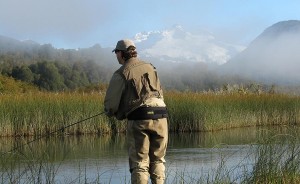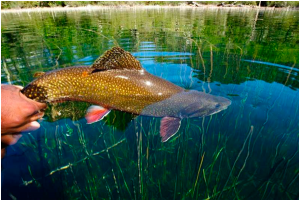Like fly fishers everywhere, I like to fish with dry flies whenever I can. It doesn’t mean I don’t like and appreciate other forms of casting a fly, it just means that seeing a trout eat a dry fly is one of the more enjoyable aspects of our sport. And while there are many places and opportunities to pursue that end, Rio Manso certainly is one of the more diverse in terms of the kinds of dry fly fishing available to visitors.
This is naturally due to the variety of the water in the surrounding Andes Mountains. Within a short 25-minute drive of the lodge are lakes, small streams, and of course, the Manso River itself. With such a variation of water types, it’s only to be expected that the fishing, and especially the dry fly fishing, would be just as distinct.
This is naturally due to the variety of the water in the surrounding Andes Mountains. Within a short 25-minute drive of the lodge are lakes, small streams, and of course, the Manso River itself. With such a variation of water types, it’s only to be expected that the fishing, and especially the dry fly fishing, would be just as distinct.
Take a look at the Rio Manso itself. Starting high in the glaciers of Mount Tronador, the Manso winds through a series of lakes, rapid water and slower stretches providing multiple fishing situations. One of the most well-known and appreciated by nearly every visitor are the so-called Channels in front of the lodge. I’ve written more about them in an earlier blog. (The Channels).
 Most fishing is to rising fish, and matching the hatch can be critical to success. It’s a surprise to many visitors, who sometimes arrive expecting to fight the famous Patagonian wind, and strip streamers all day. Yet even here there is a lot going on. Early December brings the legendary dragon fly hatch where massive browns, rainbows and brook trout rocket from the water in an attempt to capture the adults. At that time of year finding rising fish is easy as you can hear them from a hundred yards away. Size 4 or 6 dry flies are the norm, and big rubber-legged patterns work as well. Late evening brings more selective trout, as caddis and mayflies compete for the trout and angler’s attention. On the lakes, Fonck, Roca and Hess, trout stalk the shoreline and weed beds in search of prey. Here, thanks to crystal clear water, sight casting is frequently the norm.
Most fishing is to rising fish, and matching the hatch can be critical to success. It’s a surprise to many visitors, who sometimes arrive expecting to fight the famous Patagonian wind, and strip streamers all day. Yet even here there is a lot going on. Early December brings the legendary dragon fly hatch where massive browns, rainbows and brook trout rocket from the water in an attempt to capture the adults. At that time of year finding rising fish is easy as you can hear them from a hundred yards away. Size 4 or 6 dry flies are the norm, and big rubber-legged patterns work as well. Late evening brings more selective trout, as caddis and mayflies compete for the trout and angler’s attention. On the lakes, Fonck, Roca and Hess, trout stalk the shoreline and weed beds in search of prey. Here, thanks to crystal clear water, sight casting is frequently the norm.
Summer is marked by warmer waters, but even in February and March it’s possible catch fish both early and late in the day on dries. Fall brings a resurgence in dry fly fishing after the warm weather of summer. Several fall mayfly hatches coupled with multiple caddis hatches have fish feeding on top, especially during warm evenings starting by the end of March and continuing nearly all the way through April. It’s all coming up soon enough. So, when the weather turns brisk this fall, take my twisted version of Horace Greeley’s advice: Go South, adventurous fly fisher!





